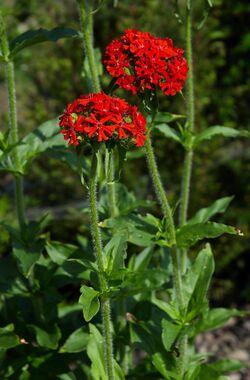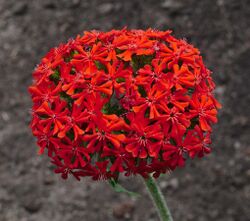Biology:Silene chalcedonica
| Silene chalcedonica | |
|---|---|

| |
| Scientific classification | |
| Kingdom: | Plantae |
| Clade: | Tracheophytes |
| Clade: | Angiosperms |
| Clade: | Eudicots |
| Order: | Caryophyllales |
| Family: | Caryophyllaceae |
| Genus: | Silene |
| Species: | S. chalcedonica
|
| Binomial name | |
| Silene chalcedonica (L.) E.H.L.Krause
| |
| Synonyms[1] | |
| |
Silene chalcedonica (syn. Lychnis chalcedonica), the Maltese-cross[2][3][4] or scarlet lychnis,[3][4] is a species of flowering plant in the family Caryophyllaceae, native to Eurasia. Other common names include flower of Bristol, Jerusalem cross[5] and nonesuch.[6]
It is a popular ornamental plant and has gained the Royal Horticultural Society's Award of Garden Merit.
Description
It is a perennial herbaceous plant growing 35–100 centimetres (14–39 inches) tall with unbranched stems. The simple, broadly lanceolate leaves are produced in opposite pairs. Each leaf ranges between 2–12 cm (1–5 in) long and 1–5 cm (1⁄2–2 in) across.
The bright red flowers are produced in clusters of 10-50 together. Each flower 1–3 cm (1⁄2–1 1⁄4 in) in diameter with a deeply five-lobed corolla, each lobe being further split into two smaller lobes. This forms a general shape similar to that of the Maltese cross to which it owes one of its common names. The fruit is a dry capsule containing numerous seeds.
Taxonomy
This plant was first formally named as Lychnis chalcedonica by Carl Linnaeus in 1753.[7] For purposes of taxonomic stability, the genus name Lychnis was formally rejected in 1994 and the name Silene was conserved.[8][9] The name Silene chalcedonica was published by Ernst Hans Ludwig Krause in 1901.[1][10]
The specific epithet chalcedonica refers to the ancient town of Chalcedon in what is now Turkey.[11]
Numerous common names are attached to this plant, including:[5][6][12]
Distribution and habitat
The species is native to central and eastern Russia, Kazakhstan, Mongolia, and northwestern China. It has naturalised in some parts of North America.[14] It can be found along roadsides and other disturbed areas, as well as open woodlands, in the northern United States and Canada.[14]
Cultivation
It is a popular ornamental plant in gardens.[15] It has gained the Royal Horticultural Society's Award of Garden Merit.[16][17] Numerous cultivars have been selected, varying in flower colour from bright red to orange-red, pink or white. It grows best in partial to full sun and in any good well-drained soil, if provided with a constant moisture supply. The flowering period is extended if faded flowers are removed. It is short-lived in poorly drained soil. Double-flowered cultivars are propagated by division.
In culture
Thomas Jefferson sowed this plant at Monticello in 1807.[citation needed]
It was voted the county flower of Bristol in 2002, following a poll by the wild flora conservation charity Plantlife.[6] Its colour is reflected in the livery and crest of the city's university.[18]
References
- ↑ 1.0 1.1 "Silene chalcedonica (L.) E.H.L.Krause". Royal Botanic Gardens, Kew. https://powo.science.kew.org/taxon/urn:lsid:ipni.org:names:157059-1.
- ↑ (xls) BSBI List 2007, Botanical Society of Britain and Ireland, https://bsbi.org/download/3542/, retrieved 2014-10-17
- ↑ 3.0 3.1 Flora of North America Editorial Committee, ed., "Silene chalcedonica", Flora of North America North of Mexico (FNA), New York and Oxford, http://www.efloras.org/florataxon.aspx?flora_id=1&taxon_id=
- ↑ 4.0 4.1 {{citation | mode = cs1 | title = Silene chalcedonica | work = Germplasm Resources Information Network (GRIN) | url = | publisher = [[Organization:Agricultural Research ServAgricultural Research Service (ARS), United States Department of Agriculture (USDA) | access-date = }}
- ↑ 5.0 5.1 Ornamental Plants From Russia: Lychnis chalcedonica
- ↑ 6.0 6.1 6.2 County Flower page on Plantlife website
- ↑ "Lychnis chalcedonica L., Sp. Pl. 1: 436 (1753).". International Plant Names Index. http://ipni.org/n/301029-2.
- ↑ Rabeler, Richard K. (February 1992). "(1034) Proposal to Conserve 2490 Silene L. against Lychnis L. (Caryophyllaceae)". Taxon 41 (1): 126–128. doi:10.2307/1222505.
- ↑ Brummitt, R. K. (May 1994). "Report of the Committee for Spermatophyta: 41". Taxon 43 (2): 271–277. doi:10.2307/1222888.
- ↑ "Silene chalcedonica E.H.L.Krause, Deutschl. Fl. (Sturm), ed. 2. 5: 96 (1901).". International Plant Names Index. http://ipni.org/n/157059-1.
- ↑ Harrison, Lorraine (2012). RHS Latin for gardeners. United Kingdom: Mitchell Beazley. pp. 224. ISBN 9781845337315.
- ↑ "Lychnis chalcedonica". EPPO Global Database. https://gd.eppo.int/taxon/LYHCH.
- ↑ "The Nonesuch: Remarkable Flower of Bristol". http://www.nonesuchexpeditions.com/nonesuch-features/the-nonesuch/nonesuch-flower-of-bristol.htm.
- ↑ 14.0 14.1 Morton, John K. (2005), "Silene chalcedonica", in Flora of North America Editorial Committee, Flora of North America North of Mexico (FNA), 5, New York and Oxford, http://www.efloras.org/florataxon.aspx?flora_id=1&taxon_id=250060837, retrieved 4 August 2020
- ↑ Flora of China: Lychnis chalcedonica
- ↑ "Lychnis chalcedonica". Royal Horticultural Society. https://www.rhs.org.uk/Plants/10600/Lychnis-chalcedonica/Details.
- ↑ "AGM Plants - Ornamental". Royal Horticultural Society. July 2017. p. 62. https://www.rhs.org.uk/plants/pdfs/agm-lists/agm-ornamentals.pdf.
- ↑ "The nonesuch". Nonesuch: Inside front cover. Autumn 2015. http://www.bristol.ac.uk/media-library/sites/alumni/documents/nonesuch/UoB_Nonesuch_Issue%2011_Design_v11AW_LORES.pdf.
Wikidata ☰ Q164019 entry
 |




